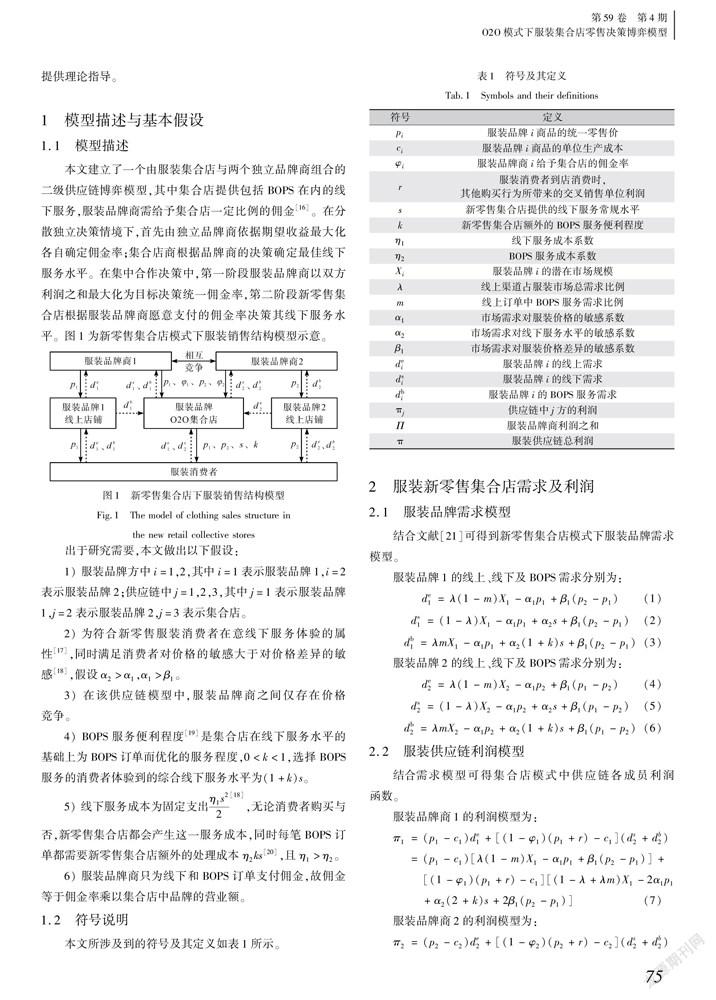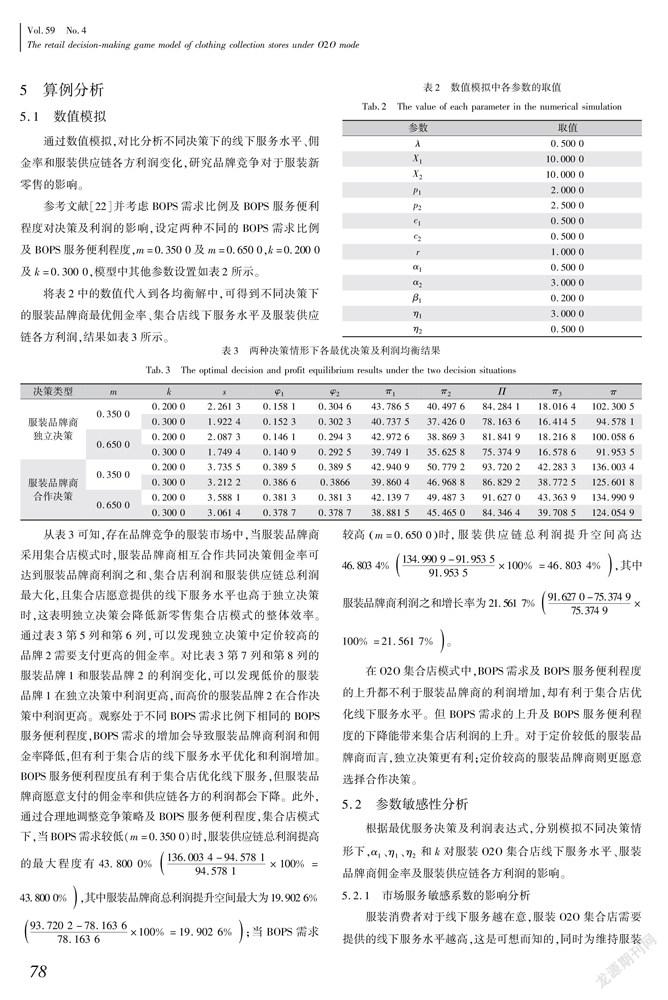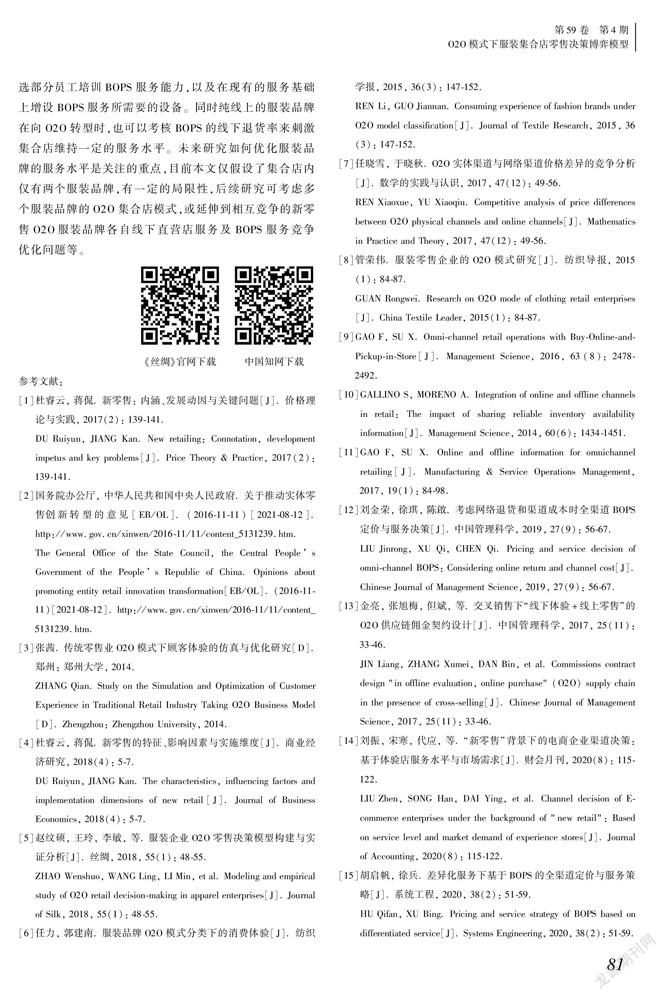O2O模式下服装集合店零售决策博弈模型
郑路 陈舒婷 张明霞 韩曙光 赵丽妍










摘要: 在O2O模式下,借助集合店渠道采用线上下单线下取货的方式开展服装零售,是近年来的行业热点。本文通过构建一个集合店与两个独立品牌商组成的二级服装供应链博弈模型,探究不同决策模式下佣金率和线下服务水平的差异化影响。模型求解和数值模拟结果表明:独立决策时,品牌商佣金率随竞争品牌定价增加而降低,消费者对于定价差异越敏感,高价服装品牌商佣金率越高;合作决策时,品牌商佣金率随任一方定价及定价差异敏感系数增加而增加;服装品牌价格越高及消费者对价格越敏感,集合店线下服务水平及利润越高;BOPS需求的上升会降低服装品牌商利润的同时增加集合店的利润。
关键词: 集合店;佣金率;线下服务;BOPS;服装零售;博弈模型
中图分类号: TS941.1文献标志码: A文章编号: 10017003(2022)04007410
引用页码: 041111DOI: 10.3969/j.issn.1001-7003.2022.04.011(篇序)
新零售是以互联网为依托,运用大数据、人工智能等技术手段,对商品的生产、流通与销售过程进行升级改造,并对线上服务、线下体验及现代物流进行深度融合的零售新模式[1]。国务院办公厅印发《关于推动实体零售创新转型的意见》,明确了推动我国实体零售创新转型的指导思想和基本原则[2]。在新零售的背景下,O2O模型以消费者体验为中心,使用互联网技术联动线上、线下资源,为顾客提供一体化服务[3]。目前,已有多家实体服装零售企业开始尝试O2O模式,门店开始运用互联网技术改装,如优衣库、迪卡侬品牌等;服装电商也纷纷尝试线上线下融合服务,如茵曼品牌等。服装消费者既能享受线上购物的低价与便利,又能获得实体店购物的优质服务体验[4],未来如何提高品牌服务体验将是服装企业管理重点。
目前,国内外针对O2O的研究现状中比较成熟的研究有赵纹硕等[5]利用层次分析法构建了服装品牌O2O零售决策体系,证明了品牌的利润与O2O的运营能力正相关;任力等[6]使用问卷调查收集了1 210名消费者,了解客户真实需求,将O2O市场细化,避免服装品牌同质化竞争;任晓雪等[7]构建由实体和网络渠道组成的双渠道O2O供应链,运用消费者效用函数模型和需求函数模型,得到电商成熟时,线上定价会高于线下定价;管荣伟[8]研究表明,向O2O模型转型需要考虑从深度整合供应链、提高实体店体验、调整企业组织架构等方面。而相对较少的研究是对线上订单线下取货(buy-online-and-pick-up-in-store,BOPS)[9]服务的研究,BOPS服务是指服装消费者在品牌线上店铺挑选款式,选择去实体店线下取货,在店内根据服务水平及产品实物决定是否购买的过程。Gallino等[10]发现全渠道实施BOPS服务会减少线上销量、增加线下销量;Gao等[11]发现BOPS服务能使零售商挖掘出新的消费者,BOPS收益可以实现线上线下跨渠道共享;刘金荣等[12]发现消费者退货率和各渠道购物成本将会决定品牌商是否增设BOPS服务。线下服务水平方面,金亮等[13]提出线上零售与线下门店融合成线下服务体验的供应链O2O模式,并借助调整佣金契约激励实体门店。刘振等[14]对比分析仅网上销售和BOPS模式下的电商定价,发现增设BOPS服务能使电商企业获利更多。胡启帆等[15]考虑需求受线下服务影响,研究线上线下同价与否对产品定价、线下服务决策和利润的影响。
现有研究表明O2O模式下实施BOPS是有利可图的,但关于BOPS服务对线下服务影响的研究较少。本文考虑到新零售背景下,相互竞争的服装品牌线下门店均采用服装集合店模式,以及O2O模式中线上线下融合的服务形式BOPS对线下服务的影响,通过分析服装品牌商不同决策下的最优佣金率及集合店的最优线下服务水平,探究O2O品牌竞争时服装品牌商和集合店如何实现利润最优,从而为服装O2O模式提供理论指导。
1模型描述与基本假设
1.1模型描述
本文建立了一个由服装集合店与两个独立品牌商组合的二级供应链博弈模型,其中集合店提供包括BOPS在内的线下服务,服装品牌商需给予集合店一定比例的佣金[16]。在分散独立决策情境下,首先由独立品牌商依据期望收益最大化各自确定佣金率;集合店商根据品牌商的决策确定最佳线下服务水平。在集中合作决策中,第一阶段服装品牌商以双方利润之和最大化为目标决策统一佣金率,第二阶段新零售集合店根据服装品牌商愿意支付的佣金率决策其线下服务水平。图1为新零售集合店模式下服装销售结构模型示意。
出于研究需要,本文做出以下假设:
表1符号及其定义
Tab.1Symbols and their definitions
符号定义pi服装品牌i商品的统一零售价ci服装品牌i商品的单位生产成本φi服装品牌商i给予集合店的佣金率r服装消费者到店消费时,
其他购买行为所带来的交叉销售单位利润s新零售集合店提供的线下服务常规水平k新零售集合店额外的BOPS服务便利程度η1线下服务成本系数η2BOPS服务成本系数Xi服装品牌i的潜在市场规模λ线上渠道占服装市场总需求比例m线上订单中BOPS服务需求比例α1市场需求对服装价格的敏感系数α2市场需求对线下服务水平的敏感系数β1市場需求对服装价格差异的敏感系数dei服装品牌i的线上需求dsi服装品牌i的线下需求dbi服装品牌i的BOPS服务需求πj供应链中j方的利润Π服装品牌商利润之和π服装供应链总利润2服装新零售集合店需求及利润
2.1服装品牌需求模型
2.2服装供应链利润模型
3模型求解
3.1服装品牌商独立决策
独立决策第一阶段,服装品牌商各自独立决定给予集合店的佣金率,第二阶段集合店根据品牌商愿意支付的佣金率决策其线下服务水平。根据逆向求解法,求解服装新零售集合店的最优线下服务水平。
3.2服装品牌商合作决策
合作决策第一阶段服装品牌商以双方利润之和最大化为目标决策统一佣金率,第二阶段新零售集合店根据服装品牌商愿意支付的佣金率决策其线下服务水平,根据逆向求解法,求解服装新零售集合店的最优线下服务水平。
4模型比较与分析
根据独立决策和合作决策下的均衡解,对比分析相关参数对佣金率、线下服务水平决策的影响。
结论1:独立决策下佣金率随竞争品牌商品定价增加而降低,合作决策下佣金率随任一方商品定价增加而增加。对于集合店而言,任一服装品牌商品定价升高,新零售集合店均会优化其线下服务水平。
表明当某一品牌价格较高时,为弥补因高价而流失的服装消费者,新零售集合店会提高其线下服务水平。此时对价格较低的一方品牌商而言,与高价品牌处于同一门店,高价品牌的价格会流失集合店的客流量,为保持较高的利润,独立决策中该品牌商会降低佣金率。而合作决策中服装品牌商一体化,追求双方利润之和最优,期望共同承担更高的佣金率以确保集合店提供优质的线下服务。
结论2:独立决策下服装品牌商双方定价的比额在一定阈值内时,市场对价格越敏感,服装品牌商愿意支付的佣金越高;价格敏感系数对定价较高的服装品牌商佣金率的影响较大。服装品牌商合作时,消费者越在意价格,服装品牌商的佣金率越高。集合店优化线下服务水平的力度随市场对定价敏感系数的增大而增大。
以上证实消费者对价格较敏感且独立决策下定价差距不大时,服装品牌商希望通过增加佣金率刺激集合店优化其线下服务水平吸引消费者,同时定价较高的服装品牌商更愿支付高额的佣金率以增加需求。服装品牌商合作决策中,消费者价格敏感时,服装品牌商希望集合店提高线下服务弥补因定价较高而流失的消费者。
结论3:独立决策时消费者对定价差异越敏感,定价较高的服装品牌商愿意支付的佣金率也越高,定价较低的服装品牌商愿意支付的佣金率则越低,集合店线下服务水平不受其影响。合作决策时随着定价差异敏感系数的增大,服装品牌商佣金率越高,集合店的线下服务水平也随之上升。
说明独立决策下,集合店提供统一线下服务,消费者在意价格差异,定价较高的一方会增加佣金率以使集合店优化线下服务水平。对集合店而言,定价较高的服装品牌商增加佣金率,定价较低的服装品牌商降低佣金率,同时定价差价带来的总需求变化为零,考虑服务成本集合店不会改变线下服务水平。合作决策下,高价品牌能带来更高的利润,品牌商愿给予更高的佣金率来刺激集合店提升线下服务水平,集合店也通过优化线下服务增加高价品牌的需求。
结论4:独立决策时,当服装品牌潜在需求与其竞争品牌潜在需求的比额在一定阈值内时,线上需求比例越高,服装品牌商的佣金率也随之增长;合作决策时,线上需求比例的增大则服装品牌商的佣金率上涨。当BOPS服务需求比例小于某个阈值时,线上需求比例的增加会伴随着线下服务水平的上升;当BOPS服务需求比例大于某个阈值时,线下服务水平随线上需求比例上升而降低,而独立决策时阈值取值高于合作决策时阈值取值。
表示当BOPS服务需求比例在一定阈值内时,集合店愿意通过改善线下服务水平来增加服装消费者到店需求;当BOPS比例超过一定阈值时,BOPS需求足够高、到店取货的消费者过多,考虑到服务成本,集合店会适当降低线下服务水平。而就服装品牌商而言,线上利润增多线下需求减少,为保证集合店维持一定水平的线下服务,服装品牌商愿增加佣金率以缓解线下服务成本。
结论5:无论处于何种决策情形,集合店的线下服务水平总随BOPS服务需求比例增加而降低。服装品牌商独立决策时,当服装品牌潜在市场需求与其竞争品牌潜在市场需求的比额在一定条件内,BOPS服务需求比例越高,服装品牌商的佣金率越低;合作时,服装品牌商的佣金率也随着BOPS服务需求比例的增加而降低。
证明BOPS需求越多,纯线上需求越少利润也越少,而纯线上利润完全属于服装品牌商,故服装品牌商为了总利润更高而降低佣金率;BOPS需求比例越高,集合店的服务成本也越高,同时服装品牌商降低佣金率,为减少成本集合店会降低其线下服务水平。
结论6:服装品牌商定价固定时,随着竞争品牌定价的增加,合作决策时服装品牌商愿意支付的佣金率与其独立决策佣金率之间的差额会越来越大。
表明当服装品牌商的定价保持不变时,竞争品牌的定价较低,独立决策时服装品牌商价格优势降低,希望通过提高佣金率引导新零售集合店优化线下服务水平增加需求;合作决策时服装品牌一体化,追求双方总利润最大,另一方定价低,商品纯利润减少,其愿提供的佣金率也较低,故竞争品牌价格较低时合作决策与独立决策之间的佣金率差额较小。而竞争品牌定价较高时,独立决策时服装品牌商具有价格优势,且线下服务水平一致,为保持较高的利润,故其佣金率较低;合作决策时,另一方定价高将导致新零售集合店总需求降低,为弥补高价带来的损失,服装品牌商增加佣金率来刺激新零售集合店提高线下服务质量,故竞争品牌价格较高时的统一佣金率与品牌商独立决策时的佣金率差额较大。
5算例分析
5.1数值模拟
通过数值模拟,对比分析不同决策下的线下服务水平、佣金率和服装供应链各方利润变化,研究品牌竞争对于服装新零售的影响。
参考文献[22]并考虑BOPS需求比例及BOPS服务便利程度对决策及利润的影响,设定两种不同的BOPS需求比例及BOPS服务便利程度,m=0.350 0及m=0.650 0,k=0.200 0及k=0.300 0,模型中其他参数设置如表2所示。
将表2中的数值代入到各均衡解中,可得到不同决策下的服装品牌商最优佣金率、集合店线下服务水平及服装供应链各方利润,结果如表3所示。
从表3可知,存在品牌竞争的服装市场中,当服装品牌商采用集合店模式时,服装品牌商相互合作共同决策佣金率可达到服装品牌商利润之和、集合店利潤和服装供应链总利润最大化,且集合店愿意提供的线下服务水平也高于独立决策时,这表明独立决策会降低新零售集合店模式的整体效率。通过表3第5列和第6列,可以发现独立决策中定价较高的品牌2需要支付更高的佣金率。对比表3第7列和第8列的服装品牌1和服装品牌2的利润变化,可以发现低价的服装品牌1在独立决策中利润更高,而高价的服装品牌2在合作决策中利润更高。观察处于不同BOPS需求比例下相同的BOPS服务便利程度,BOPS需求的增加会导致服装品牌商利润和佣金率降低,但有利于集合店的线下服务水平优化和利润增加。BOPS服务便利程度虽有利于集合店优化线下服务,但服装品牌商愿意支付的佣金率和供应链各方的利润都会下降。
在O2O集合店模式中,BOPS需求及BOPS服务便利程度的上升都不利于服装品牌商的利润增加,却有利于集合店优化线下服务水平。但BOPS需求的上升及BOPS服务便利程度的下降能带来集合店利润的上升。对于定价较低的服装品牌商而言,独立决策更有利;定价较高的服装品牌商则更愿意选择合作决策。
5.2参数敏感性分析
根据最优服务决策及利润表达式,分别模拟不同决策情形下,α、η、η和k对服装O2O集合店线下服务水平、服装品牌商佣金率及服装供应链各方利润的影响。
5.2.1市场服务敏感系数的影响分析
服装消费者对于线下服务越在意,服装O2O集合店需要提供的线下服务水平越高,这是可想而知的,同时为维持服装O2O集合店的积极性,服装品牌商愿意支付的佣金率也随之上升。从图2可发现,消费者对线下服务越敏感,服装品牌商及集合店的利润就越高,O2O中强调线下服务体验对服装供应链各成员而言是有利的。
5.2.2线下服务及BOPS服务成本系数的影响分析
对比图3—图5可知,线下服务成本系数与BOPS服务成本系数对新零售集合店线下服务水平、服装品牌商佣金率及服装供应链各成员的利润都是不利的。线下服务和BOPS服务的成本系数越高,集合店需要承担的服务成本也越高,集合店则不愿再提供更高的线下服务及优化BOPS服务,服装品牌商也不愿为低水平的集合店线下服务和BOPS服务买单,这将造成在意线下服务体验的服装消费者大量流失,服装供应链各成员的利润都会有所下降。
由图6可知,集合店提高BOPS服务便利程度时,会吸引更多偏好BOPS服务的消费者,但鉴于集合店的服务成本压力,集合店会适当降低其线下服务水平,故服装品牌商也不愿支付集合店商高额的佣金率。由于分析中假设了BOPS需求较低,优化BOPS服务便利程度虽能吸引到喜好BOPS服务的服装消费者,但集合店降低线下服务水平会失去更多在意线下服务的消费者,最终导致各方利润的损失。
6结论
本文从线下服务出发,考虑服装品牌商在O2O模式下采用集合店经营实体店,对比讨论服装品牌商独立决策和合作决策下新零售集合店的最优线下服务水平和服装品牌商的最优佣金率决策,并分析参数对线下服务水平及佣金率决策和各成员利润的影响。
结果表明,服装品牌商各自佣金率随竞争品牌定价增加而降低,统一佣金率则随任一方定价增加而增加;服装品牌价格越高及消费者对价格越敏感,集合店线下服务水平及利润越高。独立决策时,消费者对于定价差异越敏感,高价服装品牌商佣金率更高;BOPS需求的上升会降低服装品牌商的利润,却增加了集合店的利润;合作决策下服装品牌利润之和、集合店的利润及服装供应链的总利润最大,定价较低的服装品牌商独立决策更有利,定价较高的服装品牌商则更愿意选择合作决策。
服装消费者越来越重视线下服务,选择BOPS服务的服装消费者也日益增多,但面对较高的服务成本,集合店可以挑选部分员工培训BOPS服务能力,以及在现有的服务基础上增设BOPS服务所需要的设备。同时纯线上的服装品牌在向O2O转型时,也可以考核BOPS的线下退貨率来刺激集合店维持一定的服务水平。未来研究如何优化服装品牌的服务水平是关注的重点,目前本文仅假设了集合店内仅有两个服装品牌,有一定的局限性,后续研究可考虑多个服装品牌的O2O集合店模式,或延伸到相互竞争的新零售O2O服装品牌各自线下直营店服务及BOPS服务竞争优化问题等。
参考文献:
[1]杜睿云, 蒋侃. 新零售: 内涵、发展动因与关键问题[J]. 价格理论与实践, 2017(2): 139-141.
DU Ruiyun, JIANG Kan. New retailing: Connotation, development impetus and key problems[J]. Price Theory & Practice, 2017(2): 139-141.
[2]国务院办公厅, 中华人民共和国中央人民政府. 关于推动实体零售创新转型的意见[EB/OL]. (2016-11-11)[2021-08-12]. http://www.gov.cn/xinwen/2016-11/11/content_5131239.htm.The General Office of the State Council, the Central People’s Government of the People’s Republic of China. Opinions about promoting entity retail innovation transformation[EB/OL]. (2016-11-11)[2021-08-12]. http://www.gov.cn/xinwen/2016-11/11/content_5131239.htm.
[3]张茜. 传统零售业O2O模式下顾客体验的仿真与优化研究[D]. 郑州: 郑州大学, 2014.ZHANG Qian. Study on the Simulation and Optimization of Customer Experience in Traditional Retail Industry Taking O2O Business Model[D]. Zhengzhou: Zhengzhou University, 2014.
[4]杜睿云, 蒋侃. 新零售的特征、影响因素与实施维度[J]. 商业经济研究, 2018(4): 5-7.DU Ruiyun, JIANG Kan. The characteristics, influencing factors and implementation dimensions of new retail[J]. Journal of Business Economics, 2018(4): 5-7.
[5]赵纹硕, 王玲, 李敏, 等. 服装企业O2O零售决策模型构建与实证分析[J]. 丝绸, 2018, 55(1): 48-55.ZHAO Wenshuo, WANG Ling, LI Min, et al. Modeling and empirical study of O2O retail decision-making in apparel enterprises[J]. Journal of Silk, 2018, 55(1): 48-55.
[6]任力, 郭建南. 服装品牌O2O模式分类下的消费体验[J]. 纺织学报, 2015, 36(3): 147-152.REN Li, GUO Jiannan. Consuming experience of fashion brands under O2O model classification[J]. Journal of Textile Research, 2015, 36(3): 147152.
[7]任晓雪, 于晓秋. O2O实体渠道与网络渠道价格差异的竞争分析[J]. 数学的实践与认识, 2017, 47(12): 4956.REN Xiaoxue, YU Xiaoqiu. Competitive analysis of price differences between O2O physical channels and online channels[J]. Mathematics in Practice and Theory, 2017, 47(12): 4956.
[8]管荣伟. 服装零售企业的O2O模式研究[J]. 纺织导报, 2015(1): 8487.GUAN Rongwei. Research on O2O mode of clothing retail enterprises[J]. China Textile Leader, 2015(1): 8487.
[9]GAO F, SU X. Omnichannel retail operations with BuyOnlineandPickupinStore[J]. Management Science, 2016, 63(8): 24782492.
[10]GALLINO S, MORENO A. Integration of online and offline channels in retail: The impact of sharing reliable inventory availability information[J]. Management Science, 2014, 60(6): 14341451.
[11]GAO F, SU X. Online and offline information for omnichannel retailing[J]. Manufacturing & Service Operations Management, 2017, 19(1): 8498.
[12]刘金荣, 徐琪, 陈啟. 考虑网络退货和渠道成本时全渠道BOPS定价与服务决策[J]. 中国管理科学, 2019, 27(9): 56-67.LIU Jinrong, XU Qi, CHEN Qi. Pricing and service decision of omni-channel BOPS: Considering online return and channel cost[J]. Chinese Journal of Management Science, 2019, 27(9): 56-67.
[13]金亮, 張旭梅, 但斌, 等. 交叉销售下“线下体验+线上零售”的O2O供应链佣金契约设计[J]. 中国管理科学, 2017, 25(11): 33-46.JIN Liang, ZHANG Xumei, DAN Bin, et al. Commissions contract design "in offline evaluation, online purchase" (O2O) supply chain in the presence of cross-selling[J]. Chinese Journal of Management Science, 2017, 25(11): 33-46.
[14]刘振, 宋寒, 代应, 等. “新零售”背景下的电商企业渠道决策: 基于体验店服务水平与市场需求[J]. 财会月刊, 2020(8): 115-122.LIU Zhen, SONG Han, DAI Ying, et al. Channel decision of E-commerce enterprises under the background of "new retail": Based on service level and market demand of experience stores[J]. Journal of Accounting, 2020(8): 115-122.
[15]胡启帆, 徐兵. 差异化服务下基于BOPS的全渠道定价与服务策略[J]. 系统工程, 2020, 38(2): 51-59.HU Qifan, XU Bing. Pricing and service strategy of BOPS based on differentiated service[J]. Systems Engineering, 2020, 38(2): 51-59.
[16]彭浪, 张毕西, 陈晓纯. 考虑服务水平的双渠道供应链定价策略研究[J]. 数学的实践与认识, 2016, 46(24): 98-106.PENG Lang, ZHANG Bixi, CHEN Xiaochun. Research on pricing strategy of dual channel supply chain considering service level[J]. Mathematics in Practice and Theory, 2016, 46(24): 98-106.
[17]李然, 孫涛, 曹冬艳. O2O业态融合视角下的数字化新零售发展趋势研究[J]. 当代经济管理, 2021, 43(4): 13-21.LI Ran, SUN Tao, CAO Dongyan. Research on the development trend of digital "new retail" from the perspective of O2O business integration[J]. Contemporary Economic Management, 2021, 43(4): 13-21.
[18]肖剑, 但斌, 张旭梅. 双渠道供应链中制造商与零售商的服务合作定价策略[J]. 系统工程理论与实践, 2010, 30(12): 2203-2211.XIAO Jian, DAN Bin, ZHANG Xumei. Pricing strategy of service cooperation between manufacturer and retailer in dual-channel supply chain[J]. Systems Engineering Theory & Practice, 2010, 30(12): 2203-2211.
[19]CAO J, SO K C, YIN S. Impact of an "online-to store" channel on demand allocation, pricing and profitability[J]. European Journal of Operational Research, 2016, 248(1): 234-245.
[20]HUA G, WANG S, CHENG T. Price and lead time decisions in dual-channel supply chains[J]. European Journal of Operational Research, 2010, 205(1): 113-126.
[21]张琴义, 张国宝, 张德化. “互联网+”环境下BOPS模式与同价模式对比研究[J]. 系统科学与数学, 2019, 39(8): 1303-1313.ZHANG Qinyi, ZHANG Guobao, ZHANG Dehua. A contrastive study of same price channel and BOPS in the context of "Internet +"[J]. Journal of Systems Science and Mathematical Scien, 2019, 39(8): 1303-1313.
[22]王娟, 汪传旭. 考虑产品替代的供应链定价和环保水平决策[J]. 工业工程与管理, 2015, 20(6): 61-68.
WANG Juan, WANG Chuanxu. Supply chain’s pricing and the level of environmental protection decision-making with substitutable products[J]. Industrial Engineering and Management, 2015, 20(6): 61-68.
The retail decision-making game model of clothing collection stores under O2O modeZHENG Lu CHEN Shuting ZHANG Mingxia HAN Shuguang ZHAO Liyan(1.High Fashion (China) Co., Ltd., Hangzhou 311200, China; 2a.School of Fashion Design & Engineering; 2b.School of Science;
2c.Zhejiang International Institute of Fashion Technology, Zhejiang Sci-Tech University, Hangzhou 310018, China)
Abstract: In recent years, the online clothing market has become saturated, and the competition of similar clothing brands has become increasingly fierce, while the profits of the clothing industry have declined. The sales model of traditional clothing enterprises urgently needs to be broken through and transformed. The O2O mode, which takes the consumer experience as the core, combines with the convenience advantages of online shopping with unlimited space and time and the service experience advantages of offline brick-and-mortar stores, is highly compatible with the needs of clothing consumers. In the future, it will be an industry hot spot to use the collection store channel to carry out clothing retailing through online ordering and offline pickup. A secondary clothing supply chain game model is set up, which is composed of a collection store and two independent brand owners. Considering the clothing brands’ operating in the O2O collection store model, the article quantitatively describes the demand model of clothing consumers and profit function of clothing retailers from the perspective of offline services. Besides, the article adopts game theory to solve the optimal decision of the model with the help of Matlab R2016a numerical simulation, exploring the influence of the optimal decision of brand commission rate and offline service level of collection stores and related factors on the profit of supply chain members under independent and cooperative decision modes respectively.
The results show that the respective commission rates of apparel brands decrease with the increase of competitive brand pricing, and the unified commission rate increases with the increase of either party’s pricing. The offline services of collective stores increase with the increase of brand pricing; the greater the market price sensitivity coefficient, the higher the commission rate of clothing brand owners and the higher the offline service level of collection stores. As for independent decision making, the more sensitive consumers are to pricing differences, the higher commission rate of high-priced clothing brands, and the lower the commission rate of low-priced clothing brands. The offline service level of collection stores is not affected. When the clothing brand owners make cooperation decisions, the uniform commission rate of clothing brand owners and the offline service level of collection stores increase with the increase of the sensitivity coefficient of market pricing differences. Only under certain conditions, the commission rate of clothing brands increases with the increase of the proportion of online demand. There is a certain threshold, when the proportion of BOPS service demand is lower than the threshold, the higher the proportion of online demand, the lower the offline service level of the new collection store. The commission rate of clothing brand owners and the offline service level of collection stores both decrease with the increase of BOPS demand ratio, while the commission rate of clothing brand owners decreases with the increase of commodity cost. The offline service level of collection stores increases with the increase of the cross profit. When the price of the clothing brands is fixed, the higher the price of competing brands, the greater the difference between the unified commission rate for cooperative decision-making and the commission rate for independent decision-making. The more sensitive consumers are to the offline services, the higher the profits of each member of the clothing supply chain, and the convenience of BOPS services, the cost coefficient of offline services and BOPS services are not conducive to members of the clothing supply chain. The increase in BOPS demand will reduce the profit of clothing brands and increase the that of the collection store. While in the collection store, the sum of the profits of clothing brands under cooperative decision-making, and the profit of the collection store and the total profit of the clothing supply chain are the primary, the clothing brands with lower pricing are more beneficial for independent decision-making, while the clothing brands with higher prices are more willing to choose cooperative decisions.
How to optimize the service level of clothing brands will be the focus for the future research. This paper only assumes that there are only two clothing brands in the collection store, which has some certain limitations. Future research can consider the O2O collection store model with more clothing brands, or extend to the competing new retail O2O clothing brands’ respective offline direct store services and BOPS service competition optimization issues.
Key words: collective store; commission rate; offline service; BOPS; clothing retail; game model

